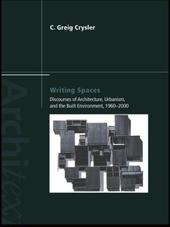
|
Writing Spaces: Discourses of Architecture, Urbanism and the Built Environment, 1960-2000
Paperback
Main Details
| Title |
Writing Spaces: Discourses of Architecture, Urbanism and the Built Environment, 1960-2000
|
| Authors and Contributors |
By (author) C. Greig Crysler
|
| Series | Architext |
|---|
| Physical Properties |
| Format:Paperback | | Pages:256 | | Dimensions(mm): Height 246,Width 174 |
|
| Category/Genre | Public buildings - civic, commercial, industrial, etc |
|---|
| ISBN/Barcode |
9780415274937
|
| Classifications | Dewey:720.1 |
|---|
| Audience | | Tertiary Education (US: College) | | Professional & Vocational | |
|---|
| Illustrations |
6 tables
|
|
Publishing Details |
| Publisher |
Taylor & Francis Ltd
|
| Imprint |
Routledge
|
| Publication Date |
26 June 2003 |
| Publication Country |
United Kingdom
|
Description
Writing Spaces examines some of the most important discourses in spatial theory of the last four decades and considers their impact within - as well as beyond - the built environment disciplines. The analysis is situated in the context of the scholarly journal, which, the author argues, has become a pre-eminent, if largely unexamined context for academic debates. Five influential publications, based in disciplines ranging from architectural history and theory to urban studies and geography, act as case studies. Drawing on theories of representation, research on globalization and the sociology and political economy of knowledge, the author explores the interplay between critical theories and the wide range of social and institutional forces that support and inform their production. Writing Spaces argues that scholarly writing influences the values that inform professional practice, and hence, the built form of cities. The case studies will be a key resource for courses in architecture, urban studies, and geography at both the graduate and undergraduate level. The accessible introduction to current paradigms of critical thought provides a crucial reference for academics conducting research in these areas. The book fosters links between architectural history and theory, geography and urban studies, placing it at the forefront of interdisciplinary debates in architecture. The innovative critical framework will also be of interest to students, teachers, and researchers in communication and media studies, linguistics and global cultural studies.
|